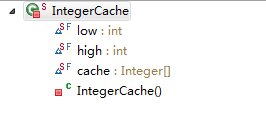1:自动装箱、拆箱
例子:
Integer a = 10; //this is autoboxing //上面的操作其实就是下面这个,编译器会帮你自动转,不用手动 Integer b = Integer.valueOf(10); //under the hood
看下Integer中valueOf(int i)的方法介绍
public static Integer valueOf(int i) { assert IntegerCache.high >= 127; if (i >= IntegerCache.low && i <= IntegerCache.high) return IntegerCache.cache[i + (-IntegerCache.low)]; return new Integer(i); }
好像是IntegerCache中去查找 i,找到了就返回,找不到就自己new一个Integer(i);
那我们去看看IntegerCache是个什么东西...
2:Integer的缓存机制

其实IntegerCache是Integer的一个内部类
/** * Cache to support the object identity semantics of autoboxing for values between * -128 and 127 (inclusive) as required by JLS. * * The cache is initialized on first usage. The size of the cache * may be controlled by the {@code -XX:AutoBoxCacheMax=<size>} option. * During VM initialization, java.lang.Integer.IntegerCache.high property * may be set and saved in the private system properties in the * sun.misc.VM class. */ private static class IntegerCache { static final int low = -128; static final int high; static final Integer cache[]; static { // high value may be configured by property int h = 127; String integerCacheHighPropValue = sun.misc.VM.getSavedProperty("java.lang.Integer.IntegerCache.high"); if (integerCacheHighPropValue != null) { try { int i = parseInt(integerCacheHighPropValue); i = Math.max(i, 127); // Maximum array size is Integer.MAX_VALUE h = Math.min(i, Integer.MAX_VALUE - (-low) -1); } catch( NumberFormatException nfe) { // If the property cannot be parsed into an int, ignore it. } } high = h; cache = new Integer[(high - low) + 1]; int j = low; for(int k = 0; k < cache.length; k++) cache[k] = new Integer(j++); // range [-128, 127] must be interned (JLS7 5.1.7) assert IntegerCache.high >= 127; } private IntegerCache() {} }
Javadoc:详细的说明这个类是用来实现缓存支持,并支持 -128 到 127 之间的自动装箱过程。最大值 127 可以通过 JVM 的启动参数 -XX:AutoBoxCacheMax=size 修改。 缓存通过一个 for 循环实现。从小到大的创建尽可能多的整数并存储在一个名为 cache 的整数数组中。这个缓存会在 Integer 类第一次被使用的时候被初始化出来。以后,就可以使用缓存中包含的实例对象,而不是创建一个新的实例(在自动装箱的情况下)。
IntegerCache中的定义的Integer cache[]数组中存的就是Integer类型的缓存对象,谈到这里,我们不禁想问,为什么缓存Integer而不缓存int这种基本数据类型?
其实原因有好多种,可以大致说出几个原因:
1)Integer是对象类型,存在堆上面,int这个数据类型时基本数据类型,存在栈上面 or 堆上面?,栈上面是临时的,容易出栈;
基本数据类型是放在栈中还是放在堆中,这取决于基本类型声明的位置。
3:基本数据类型存放位置
一:在方法中声明的变量,即该变量是局部变量,每当程序调用方法时,系统都会为该方法建立一个方法栈,其所在方法中声明的变量就放在方法栈中,当方法结束系统会释放方法栈,其对应在该方法中声明的变量随着栈的销毁而结束,这就局部变量只能在方法中有效的原因
在方法中声明的变量可以是基本类型的变量,也可以是引用类型的变量。
(1)当声明是基本类型的变量的时,其变量名及值(变量名及值是两个概念)是放在方法栈中
(2)当声明的是引用变量时,所声明的变量(该变量实际上是在方法中存储的是内存地址值)是放在方法的栈中,该变量所指向的对象是放在堆类存中的。
二:在类中声明的变量是成员变量,也叫全局变量,放在堆中的(因为全局变量不会随着某个方法执行结束而销毁)。
同样在类中声明的变量即可是基本类型的变量 也可是引用类型的变量
(1)当声明的是基本类型的变量其变量名及其值放在堆内存中的
(2)引用类型时,其声明的变量仍然会存储一个内存地址值,该内存地址值指向所引用的对象。引用变量名和对应的对象仍然存储在相应的堆中
所以如果Integer cache[]数组中存的int这个基本数据类型,有可能在栈上面就会丢失,达不到cache的效果
2)Integer是对象类型,对象类型持久,更加符合面向对象的思想?